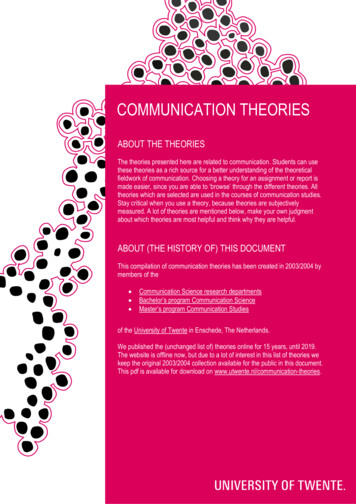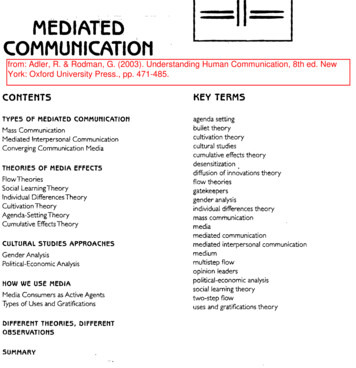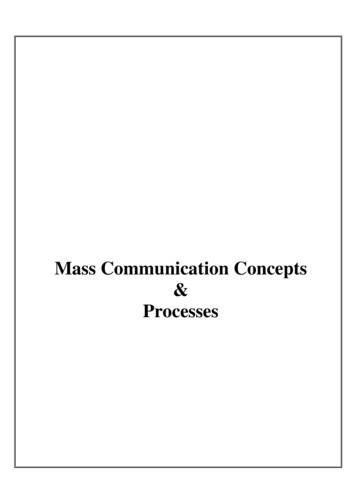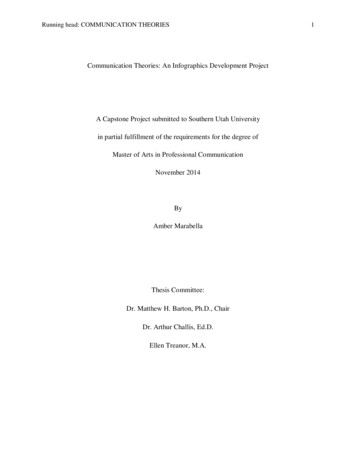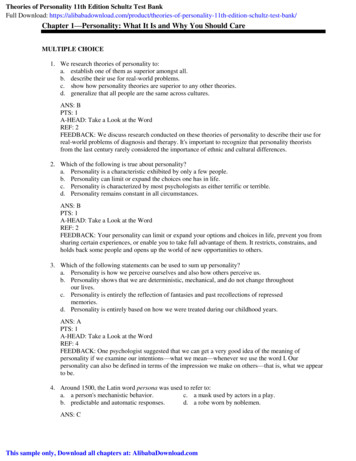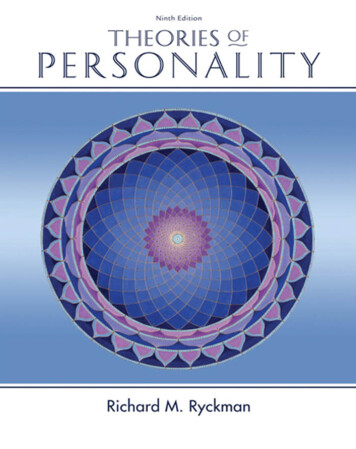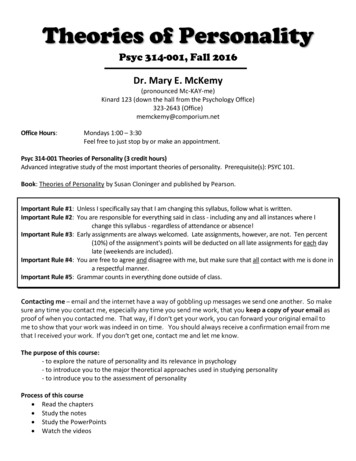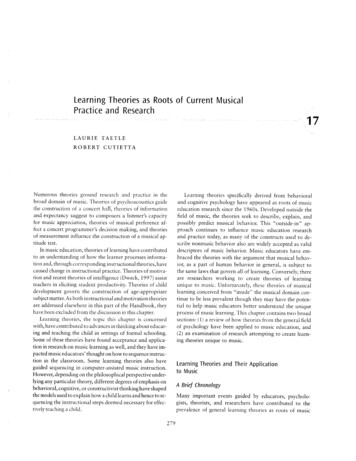
Transcription
THEORIES OF LAWNatural Law, Legal Positivism, TheMorality of LawDworkin's "Third Theory of Law"Legal Realism and Critical Legal Studies1. Thomas Aquinas and Natural Law TheoryNatural law theory like legal positivism has appeared in a variety of forms and in manyguises. One of the most elaborate statements of natural law theory can be found inAquinas who distinguished four types of law: eternal, divine, natural, and man-made. So,according to Aquinas, eternal law reflected God's grand design for the whole shebang.Divine law was that set of principles revealed by Scripture, and natural law was eternallaw as it applied to human conduct. Man-made law was constructed by human beings tofit and accommodate the requirements of natural law to the needs and contexts ofdifferent and changing societies. Also, according to Aquinas, the fundamental precepts ofnatural law were not only ascertainable (mere mortals like you and me could and did findthem out) but self-evident, i.e., they required no proof. They were, in Aquinas' terms, perse nota, known through themselves. Like his predecessor, Aristotle, Aquinasdistinguished two kinds of reasoning: theoretical and practical. Human beings werecapable of both sorts of reasoning. Theoretical reason was the capacity to apprehendcertain truths, such as the truths of mathematics. Practical reason was the capacity toapprehend those principles guiding human conduct which tell us how we ought to live,what things we should value, what goods we should seek, and how we ought to order ourlives. Like Aristotle, Aquinas believed that there were principles of practical reason andthat they were no less fundamental than the principles of theoretical or speculativereason. Thus, for Aquinas, the principle of non-contradiction was as self-evident as thefirst and most fundamental principle of natural law ("Good is to be done and evil is to beavoided"). Like the principle of non-contradiction, the precepts of natural law were,according to Aquinas, general and unchanging. They were the same for everyone. Butman-made or human law has to take the particularities of each human situation intoaccount. Man-made law must adjust natural law to specific and often changingcircumstances. Man made law is accommodating and changeable. Furthermore, there are1
areas of human conduct where natural law does not spell out the particular ways thathuman beings ought to behave themselves. Natural law does not dictate, for example, thatwe drive on the right hand side of the road. Human communities require a host ofregulations simply in order to function (traffic and tax laws). But even these regulationsare guided, albeit somewhat distantly, by natural law, i.e., by the requirement of naturallaw that health and safety be protected. Man-made law may, of course, conflict withnatural law or fail to capture some fundamental feature. Aquinas argued that human lawsthat contravene natural law are "acts of violence," and "a perversion of law." Such lawshe argued do not bind the conscience. They have no legal validity and cease, in thisregard, to be law.2. Martin Luther King's "Letter from a BirminghamJail"King: "You express a great deal of anxiety over our willingness to break laws. This iscertainly a legitimate concern. Since we so diligently urge people to obey the SupremeCourt's decision of 1954 outlawing segregation in the public schools, it is rather strangeand paradoxical to find us consciously breaking laws. One may well ask 'How can youadvocate breaking some laws and obeying others?' The answer is found in the fact thatthere are two types of laws: there are just and there are unjust laws. I would agree withSaint Augustine that 'An unjust law is no law at all.' . . . A just law is a man-made codethat squares with the moral law or the law of God. An unjust law is a code that is out ofharmony with the moral law. To put it in the terms of Saint Thomas Aquinas, an unjustlaw is a human law that is not rooted in eternal and natural law."3. John Austin and Legal PositivismWhat is law? On Austin's nineteenth century view it is (quite simply) a command issuedby a sovereign. Law is the expression of a desire (I would like you to do this, i.e., "Iwould like you to pay your taxes by April 15th" or "I would like you to stop at this redlight") backed up by a credible use of force or threat of punishment. In making sense ofhis definition, Austin refused to bring in any value-laden or normative criteria to clarifyits key terms.2
So, for example, he did not define "sovereign," for instance, as someone whohad a "right to rule." Nor did he ever argue that the use of force by a sovereign toback up his commands had to be "legitimate." The "sovereign," according toAustin, was simply that person or entity whom most people living within a giventerritory happen to obey but who does not himself obey anyone else. The"sovereign" is simply the fellow (or fellows) who is (who are) obeyed rather thanthe one (ones) doing the obeying; the sovereign is the "unobeying obeyed." Thesovereign, for Austin, is not that person who exercises a legitimate use of forcewithin a given territory. He is simply the person whose threats of punishment thepeople who live in that territory find credible. His threats merely need to becredible or convincing to the people who live in the territory. The matter oflegitimacy, of the legitimate exercise of force, is a moral issue, a separate issue,and Austin was eager to establish a way of speaking about "the law" that wasvalue-neutral. It is not that Austin did not believe that we could not evaluate alegal system in moral terms, or that we could not pass moral judgment on this orthat legal ruling within a given territory. We could and, of course, we do makethese sorts of judgments all the time but he believed that it was important toidentify the law itself in non-moral terms, that legality was separable frommorality. The great advantage of Austin's definition lies its simplicity, but in itssimplicity it may simultaneously fail to capture certain features of the law that weintuitively suspect are intimately bound up with it. In its simplicity too Austin'sdefinition is seemingly open to several knock-down objections.4. Austin's command theory of law and theseparability thesis.So on Austin's command theory a law is a desire backed up by a threat. Do all laws fitthis model? Austin's theory seems to work best if the prime examples are drawn fromcriminal law. But what about other areas of the law? Take, for instance, the law ofcontracts or wills. If my mother makes out a will leaving the rusting sculpture in her3
garden in Arlington to the neighbors is she being threatened with punishment? What ifshe fails to make a will or she types it out and fails to sign it? Hasn't she then simplyfailed to give effect to her wishes? Isn't it better, more accurate, in this instance todescribe the law of wills as empowering or enabling my mom to do certain things ratherthan as commands backed up by threats? In any case, who is threatening her in this case,who is commanding her?Austin might try to deal with this sort of objection by saying that in a case such asthis my mother is (after all) being threatened. She is threatened with the sanctionof nullity. If she fails to conform to the law of wills, whether by failing to make outa will or failing to fill it out properly, she is threatened by the sovereign's lack ofsupport. If she fails to make out a will or fills it out improperly, the sovereign willnot give effect to her "will.". The sculpture may have to sit in her back yard aftershe dies and continue to rust away, perhaps becoming part of the estate and (inthe absence of a will) going (Heaven forbid!) to me and my brother. So she is"punished" after all.But what then about the constitution? Does constitutional law fit Austin's model?In one sense the Constitution is law about law. It frames the practices oflegislation, saying, in effect, what laws can and cannot be made, or moreaccurately what laws are valid and which are not. The Constitution, you mightsay, lists a set of conditions that legislation must meet. But are legislators beingcommanded and by whom? As in the instance of the law of wills, doesn't it makemore sense to describe Constitutional law as a system of relative powers andcompetencies designed to give effect to the fundamental assumptions and basicunderstandings of a people living within a given territory? And what if we, most ofthe citizens, say, of the United States, decided one day to reject the Constitution?Would we be punished? By whom? Who would punish us?4
These questions raise another question about Austin's command theory of law.Who, after all, is the sovereign? Do all systems of law have sovereigns in theAustinian sense. Think of our own constitutional democracy. Do we have asovereign? Where is she? In the sense that we think of ourselves as beingsubject to a sovereign, it is we ourselves (we, the people) who are the sovereign.We are in charge and so supposedly obey no one but ourselves. We are, in thissense, both obeyer and obeyed. Insofar as Austin can make sense of our legalsystem in light of his model, it loses (Austin's model begins to lose) its simplicity,begins to lose the very thing that made it attractive as a model in the first place.But worse it may in the case of our limited government not only become morecomplicated but incoherent. Given our system of limited government, Austinwould have to say that we, the people as sovereign limit ourselves. But thesovereign, the one doing the commanding, is meant to be distinguishable fromthe people, i.e., from the ones doing the obeying.One way, of course, to make the necessary distinction and so to preserveAustin's picture is to distinguish ourselves in light of different roles and capacities.So we command in our capacity (role) as guardians of the public will ourselves inour capacity (role) as private citizens. We speak out of both sides of our mouthsat once, but in different voices, expressing different aspects (sides) of ourselves,a public and private side. The public voice commands and says, for example, "weshall have more public schools," and the private voice obeys, saying "I shall paymore taxes." But now to distinguish clearly between these two sides of thesovereign coin, as it were, we need to be able to distinguish the two differentsides of ourselves, to be able to distinguish when we are acting in a privatecapacity and when we are acting in our public capacity.5
And to make this distinction, we need to bring in some notion of official capacitybut there is nothing in Austin's model of the law that allows us to make thisdistinction. Imagine that the House of Representatives and the Senate gottogether in a joint session of Congress and passed a law that made eachmember of both Houses "King (and the few instances where it would beappropriate 'Queen') for a day." Say, too, that the legislation they pass states thateach member will return to his or her constituency on a specified day and theconstituents will, on that day, serve their Representative and Senators, i.e, bybringing them gifts, kissing their feet, etc. Few of us would be inclined to say thatthis vote in Congress had made "law," since the members of both houses wouldnot have been acting in their "official" capacity. Austin's theory, however, has noroom for official capacity. His theory only sees the people who happen on thisoccasion to be commanding and who might on some other occasion be obeying.If he relies exclusively upon his model and he relies on nothing else, he will notbe able to explain or understand why this decision by the Congress was not law.5. H. L. A. Hart and the separability thesisIn "Positivism and the Separation of Law and Morals" H. L. A. Hart rejects Austin'scommand theory but holds on to the separabilty of law and morals thesis. A furthercriticism of Austin's model was that it could not remain value-neutral and still claim toprovide us with an accurate picture of the law. In other words Austin's model could notaccount for what is essential to each and every legal system without bringing morality in.Two sorts of objections have been raised. In his essay Hart seeks to respond to both ofthem. First, it has been objected that to apply even the simplest "law" the exercise ofmoral judgment is required. So, for example, to apply the rule "No vehicles in the park"to the specific case of a rocket-powered skateboard requires, or so it is argued, one toanswer the question "Should rocket-powered skateboards be allowed in the park?" Again,there is nothing in Austin's command model that would enable us to answer this question.But these sorts of questions arise all the time. Judges are frequently in the position ofhaving to apply rules to new cases. Is a rocket-powered skateboard a vehicle? What abouta motorized wheelchair? Now of course, Austin might answer this objection by sayingthat the answers to these two questions are perfectly obvious, that all rules of law can be6
unambiguously and straightforwardly applied to any situation with complete illogicalcertainty. But this would be a bit hard to swallow.Hart offers a more convincing response. He argues that it is not necessary torush to moral judgment to answer either of these questions. Judges can resolvethese questions by looking at broader social policies as well as at the purposesof the rule. Relying on social policy and the purposes of the legislation does notnecessarily require judges to make moral judgments or to insert their own opinioninto the outcome. Hart further argues that the "hard" cases, the "fuzzy" ones, the"penumbral" ones, can be resolved by turning to accepted social policies andpurposes and that this can be done without our having to bring morality in.Ronald Dworkin disagrees with Hart on this point, but Hart - in this - takesAustin's view another step. Legal positivism can take a variety of forms. Austin'sview is one of them. For positivists, law is that which has been "posited," i.e.,"made," "enacted," or "laid down" in some prescribed fashion. In this regard, it isa deeply human product, an invention, "artificial" rather than "natural." It is neithergiven nor discovered, but made. On Austin's view, for instance, law is bestunderstood as a system of orders, rules, or commands enforced by power. Onthis view, a rule of law need have no connection whatsoever with what is morallyright or wrong in order to count (in order to qualify) as law. There is no necessaryconnection between what law is and what it ought to be. In contrast to thepositivist position, naturalism holds that what we call "law" can only beadequately understood in light of certain moral standards and judgments. Whatwe regard as law, what we respect as law is essentially bound up with andgrounded in "a natural moral order." This "natural moral order" is not made up byany particular group of individuals or something concocted at some convention.But "out there," as it were, to be discovered. Naturalism holds that social andpolitical practices and institutions are to be measured against these "higher"standards and where a rule of law falls short, i.e., fails to measure up to these"higher" standards, it also fails in some fundamental sense to qualify as law.7
On the positivist view it does follow from the fact that something (some rule) is arule of law that it is also morally good and right. It may be morally good and thenagain it may not. But if it isn't morally good, it is still a law nevertheless so long asit was enacted according to the prescribed procedures. There are also manyrules that are rules of law that do not appear to have anything remotely to do withwhat is morally right and wrong. Take, for example, the traffic regulation whichstates that cars must drive (in this country) on the left-hand side of the road. Nowa further objection to the positivist thesis has come from those who have had tolive under an evil regime such as the regime which came into being under theNational Socialists in Germany in 1933. These critics complain that the positivistposition that a rule can be a rule of law even if it is immoral can have perniciouseffects. If one insists that laws can remain valid even if immoral, this can beexploited by evil regimes to their advantage. Indeed this position was exploitedby those convicted of war crimes at Nuremberg when defendants at the Trialsclaimed to have just been following orders, insisting that their actions were"within the law."6. Hart's Concept of Law: Primary and SecondaryRulesAs Dworkin points out in his essay "The Model of Rules," Hart's positivism is "morecomplex" than Austin's. Hart's version also avoids some to the problem's of Austin'sversion by doing away with the idea of a commander, someone who issues orders orcommands to a people who then obey. One repeated criticism of Austin's legal positivismwas its side-stepping of the issue of what Lon Fuller called "the fidelity to law." Peoplegenerally show respect for the law or exhibit a sense of obligation to adhere to this or thatlegal statute because they believe it (the statute) to be authoritative in some way. They donot adhere to the statute merely because it was promulgated by some super-powerful"other" who threatens them with punishment and has the wherewithal to carry it out.Austin's account fails to capture this "feature" of law, although in his defense he might8
well argue that to insist on the authoritativeness of this or that statute is only a way ofsmuggling morality back into the concept of law which is best understood in valueneutral terms. Here the debate comes down to what we happen to believe is or is notessential to the law, what we suspect intuitively are its central ingredients. But critics ofAustin have been eager to point out that "there is a difference between a valid law and theorders of a gunmen." (Dworkin) Hart meets this criticism of the positivist approach tolaw by re-fining the notion of a rule, basing that notion on two different ways in which arule may carry weight, i.e. have authority. A rule may become authoritative by (1)because a people come to accept the rule as a standard for their conduct. It is not oftenthat they follow the rule, no ,matter how regularly and consistently. For example, mostAmericans get up in the morning and go to sleep at night , but they do not make it a rulein that sense that they regard this rule as binding on their behavior. Nor would theyappeal to this practice as a justification for their behavior or a reason for criticizing otherpeople's behavior who fail to obey it. A rule may also (2) become authoritative by beingenacted according to some set of secondary rules which specify the procedures thatpersons must follow to bring a rule into being. Hart calls the first set of rules primaryrules and the second set secondary According to Hart traditional societies, tribes andclans often have primary rules without secondary ones. These societies, he argues,cannot, strictly speaking, be said to have a legal system. A legal system comes into beingwith the addition of secondary rules. Hart also refers to these secondary rules as "rules ofrecognition."7. Hart's "Rules" and Dworkin's "Principles"Dworkin argues that Hart's analysis is incomplete since it fails to take note of theprinciples upon which judges rely to make their decisions, principle that are not readilycaptured by Hart's notion of primary or secondary rules. Lawyers and judges make use ofprinciples that do not function as rules and when they do, they are not relying onsomething "outside" or "beyond" the law. Dworkin clarifies the distinction between rulesand principles by analyzing the judgments in two cases: Riggs v. Palmer (1889) andHenningsen v. Bloomfield Motors, Inc. (1960). In Riggs Dworkin argues the court reliedon the principle that "no one should profit from his or her own wrongdoing" and inHenningsen on the principle that "in a society such as ours the automobile manufactureris under a special obligation in connection with the construction, promotion, and sale ofhis cars." Dworkin believes that the standards set out in these cases and to which thejudges ultimately appeal are not the sorts of things we think of as legal rules: "They seemvery different from propositions like 'The maximum legal speed on the turnpike is sixtymiles an hour' or 'A will is invalid unless it is signed by three witnesses.' Rules operate inan all-or-nothing fashion. But this is not the way principles operate. Now principles canbe treated in two different ways in the context of legal obligation. "We might," asDworkin argues, "treat legal principles the way we treat legal rules and say that someprinciples are binding as law and must be taken into account by judges and lawyers who9
make decisions of legal obligation." The "law" then (what the law is) would include bothrules and principles. Or, as Dworkin says, "we might deny that principles can be bindingthe way some rules are. We would then say that in cases like Riggs v. Palmer, the judgereaches beyond the rules that he is bound to apply (reaches, that is, beyond the 'law') forextralegal principles." Which view we adopt is not, not just, a matter of convenience. Theview we adopt will have serious consequences on how we think of judicial activism,discretion, democracy, and legal obligation.8. Dworkin's "Third"Theory of LawOne of Dworkin's main concerns has been to develop and defend a theory ofinterpretation, of adjudication, to offer an account of how courts (and judges) not only dodecide hard cases but how they ought to decide hard cases, i.e., those cases in which thesettled rules run out or in which no settled rule applies. It is also this concern that fuelsDworkin's critique of Hart. His key insight is his perception that when judges reasonabout hard cases, they appeal to principles and standards other than positivistic rules, i.e.,those rules that are identifiable by virtue of their pedigree, by how they came about asspecified by some set of secondary rules or "rules of recognition." Unlike legal rules,principles have no discernable "pedigree" in Hart's sense. Principles function as a reasonin favor of a particular decision, but do not compel a result in the way a rule does. Alsounlike a legal rule in Hart's sense, a principle, such as the principle to which the courtreferred in Riggs, can, according to Dworkin, remain a principle even though it may notalways be followed. Principles, too, frequently give expression to background rights heldby one of the parties to a dispute, and such rights frequently "trump" or take priority overother considerations. Are principles a part of the law or do they stand outside of it? Hart'stheory, Dworkin argues, must treat principles as standing outside the law, as extra-legalstandards to which judges may sometimes appeal, but if they do, judges are then nolonger bound by any legal authority; they are acting outside the law.Dworkin argues that Hart's view is both descriptively inaccurate and morallyunattractive. It is inaccurate because courts do, Dworkin claims, invoke principlesand background rights in making decisions; and unattractive because it leavesjudges free to exercise their discretion in other ways, i.e., by invoking policyconsiderations and ignoring a defendant's background rights. Dworkin has alsotried to fit his theory of law into a context of other theories of interpretation, inparticular theories of interpretation directed at literary texts. What makes one10
interpretation "right" or "better" than some other? Is all interpretation merely a"subjective" process in which the interpreter of a text merely imposes whatevermeaning he or she chooses? Is there a sense in which the interpretation of a textcan be said to be "objective?" Are there meaningful constraints on interpretiveactivity, distinct from political decision making? Dworkin argues that a conceptionof judicial interpretation must follow from a more general interpretation of what itmeans to interpret anything, be it a text or a work of art. In these latter cases,interpretation proceeds "from the inside out." To grasp the meaning of a play, forinstance, one must understand what it means not only to the author but to theactors, director, audience, and critics, whose play it is. So, too, to understand asocial practice such as the law involves the attempt to understand it as a way oflife created and sustained by its members, people who see themselves as part ofa larger community ("a community of principle," "an interpretive community") heldtogether by a commitment to the rule of law. Ands this means, Dworkin believes,that interpretation must involve more than discovering the intent of the author of aplay or the drafters of a statute. Interpretation must be constructive. Interpretersmust see the play or the law in its best light, as the coherent embodiment ofsome theme or point.For judges seeking to make sense of a series of earlier precedents they mustseek to find the best constructive interpretation of the legal doctrine as it isexpressed in those precedents. A judge is, in this respect, like a contributor to a"chain novel." He must take into account what has come before in such a way asto find some thread, some narrative line to continue, and he must think creativelyin order to tell the story beyond the point that it has so far been told. When twointerpretations conflict, judges must decide which reading fits best with thefundamental features of our law as well as which reading presents our law assomething coherent and worthwhile, as something of value. The law is theproduct of that interpretation which most faithfully sums up the texts, principles,11
background rights, and values of a given community into a coherent and morallyattractive whole. This is a naturalism, if it is a naturalist theory at all, of a verydifferent sort than that expressed by Aquinas or Martin Luther King. Judges, onDworkin's view, are not free to appeal to any moral principle nor do the principlesto which they do appeal derive their validity from some natural moral order.Dworkin's judges are permitted to acknowledge only those principles and valueswhich reside, explicitly or implicitly, in the legal history and tradition of theircommunity.9. Oliver Wendell Holmes and Legal RealismAn alternative theory to both positivism and naturalism is legal realism. Legal realistswere especially concerned with "law in action" rather than with "law in books, with whatlawyers and judges in fact do in the course of their practice of the law rather than whatsome legal theorist may say he thinks the law is like. To understand legal realism it ishelpful to grasp the picture of law to which the legal realists objected the most. In 1870 aseries of reforms in legal education were introduced by the new dean of Harvard LawSchool, Christopher Langdell. The aim of the new reforms was the teaching of law as ascience. Other law schools quickly followed suit. Underlying the new reforms andmethods was a conception of law as a completely self-contained and thoroughlyconsistent body of rules. Once a judge or "student of the law" extracts the law fromauthoritative sources, he or she can logically deduce what conclusion that rule requires inany given case. On this view every legal dispute, every argument, was believed to have aunique solution, a single correct answer that could be rigorously deduced from a set ofbasic axioms. Oliver Wendell Holmes was one of the first to attack this picture of thelaw. "The life of the law has not been logic," he remarked, "it has been experience." And,as far as Holmes was concerned, the experience most relevant to our coming to "see" whylaw looks and works the way it does is the experience and point of view of the "badman," that person whose primary concern is the bottom line, who asks "How much can Iget away with before I bring the power of the state down on my head?"So, Holmes argued, a contract is not a moral commitment that the law wants meto keep; it is not, as it were, simply, a promise in writing, but a transaction whichoffers each party to the arrangement a choice: either give what is required by the12
contract and take what is offered or take what is offered, fail to give what isasked, and pay the penalty. In order to understand the nature of contracts, tounderstand the nature of contract law, you have to see it from the "bad man's"perspective. Contract law is designed with this "bad guy" in mind; its provisionsare "triggered" by what this "bad guy" might do. Thus, contract law exhibits theprudence of distrust and presupposes that the parties are held together bycombinations of self-interest and calculation rather than mutual affection andlove, that each party is out to get what is best for himself without regard to thewelfare of the other. The law presumes that the parties do not "care" for eachother. Holmes argued that the best way to understand the law is to be able topredict when and under what circumstances one's conduct will trigger the powerof the state. By washing the law in this "cynical acid," Holmes sought to boil lawdown to its essence. Realists also take exception to the picture of law as a selfcontained deductive system of rules, accompanied by the belief in a method ofarriving at determinate solutions to problems of legal choice. This is what mightbe called the realist's rule-skepticism: "The law consists of decisions, not ofrules." The law is not a rigid body of fixed and unchanging rules but a shifting andflexible social institution, with sufficient play, sufficient give-and-take, toaccommodate the balancing of competing interests within a society.So, too, legal realists take issue with the doctrine of precedent, the idea that acourt's decision in one case can serve as a guide to future cases that are similarin relevant ways. Realists emphasize the indeterminacy and looseness of the use
Saint Augustine that 'An unjust law is no law at all.' . . . A just law is a man-made code that squares with the moral law or the law of God. An unjust law is a code that is out of harmony with the moral law. To put it in the terms of Saint Thomas Aquinas, an unjust law is a human law that is not rooted in eternal and natural law." 3.
